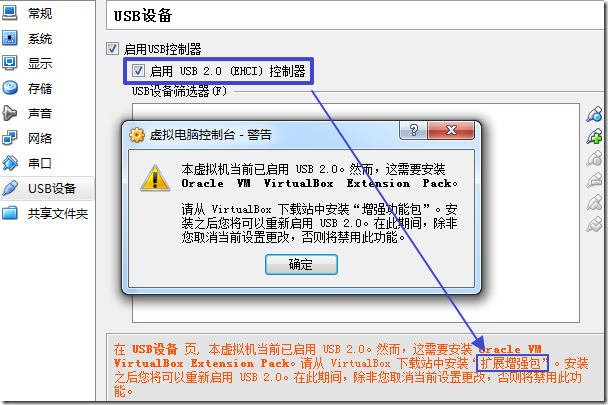之前就介绍过VirtualBox了,其中也提到,有些高级一些的功能,比如剪贴板共享,文件夹共享等,是需要安装Guest Additions
【教程】如何为VirtualBox安装 Guest Additions/增强工具包/功能增强包/增强功能包
其中,我把Guest Additions,翻译为增强工具包,功能增强包,增强功能包。
但是后来才发现,貌似VirtualBox中,还有另外一个东西,英文叫做Extension Pack,中文也可以,而且更加适合,被翻译为 功能增强包。
其中,VirtualBox的中文界面中,是将Extension Packs,翻译为“扩展增强包”:
所以,此处,找了半天,也没找到更好的翻译。
自己斟酌了半天,觉得貌似把Guest Additions翻译为:
客户端增强包
或许,比较合适些。
客户端增强包(Guest Additions)
关于Guest Additions的官网解释是:
Guest Additions: shared folders, seamless windows, 3D virtualization. The VirtualBox Guest Additions are software packages which can be installed inside of supported guest systems to improve their performance and to provide additional integration and communication with the host system. After installing the Guest Additions, a virtual machine will support automatic adjustment of video resolutions, seamless windows, accelerated 3D graphics and more. The Guest Additions are described in detail in Chapter 4, Guest Additions.
In particular, Guest Additions provide for "shared folders", which let you access files from the host system from within a guest machine. Shared folders are described in the section called “Shared folders”.
翻译之前,先强调一些概念:
在virtualBox中安装的操作系统,叫做虚拟机,英文叫做client,
和当前主机Host相对。
很常见的例子是:你在Host为Win7的系统中的virtualBox中,安装了XP的Client虚拟机。
Host就是Win7,Client就是XP。
更多解释,参见:
翻译为中文就是:
客户端增强包,主要作用是为了增加:共享文件夹,无缝窗口,3D虚拟化显示。
这个客户端增强包呢,是一堆软件包的集合,是在虚拟机(Client)内安装的。
目的在于,提升,虚拟机的性能,增加和主机Host之间的交互性和通讯。
(注:由此,便容易理解了:
- 3D虚拟化显示:就是为了增加显示方面的性能
- 共享文件夹,剪贴板共享:就是为了实现,虚拟机Client和主机Host之间的交互性的。
)
装了 客户端增强包后,虚拟机里面,就可以支持 自动调整分辨率,无缝窗口(虚拟机的显示窗口和virtualBox的窗口间),以及3D加速,甚至更多其它功能了。
关于客户端增强包的详细解释,可参见:Chapter 4, Guest Additions
关于共享文件夹,可参见:section called “Shared folders
扩展增强包(Extension Pack)
关于Extension Pack,官网的解释是:
Installing VirtualBox and extension packs
VirtualBox comes in many different packages, and installation depends on your host operating system. If you have installed software before, installation should be straightforward: on each host platform, VirtualBox uses the installation method that is most common and easy to use. If you run into trouble or have special requirements, please refer to Chapter 2, Installation details for details about the various installation methods.
Starting with version 4.0, VirtualBox is split into several components.
The base package consists of all open-source components and is licensed under the GNU General Public License V2.
Additional extension packs can be downloaded which extend the functionality of the VirtualBox base package. Currently, Oracle provides the one extension pack, which can be found at http://www.virtualbox.org and provides the following added functionality:
The virtual USB 2.0 (EHCI) device; see the section called “USB settings”.
VirtualBox Remote Desktop Protocol (VRDP) support; see the section called “Remote display (VRDP support)”.
Intel PXE boot ROM with support for the E1000 network card.
Experimental support for PCI passthrough on Linux hosts; see the section called “PCI passthrough”.
VirtualBox extension packages have a
.vbox-extpackfile name extension. To install an extension, simply double-click on the package file, and the VirtualBox Manager will guide you through the required steps.To view the extension packs that are currently installed, please start the VirtualBox Manager (see the next section). From the "File" menu, please select "Preferences". In the window that shows up, go to the "Extensions" category which shows you the extensions which are currently installed and allows you to remove a package or add a new one.
Alternatively you can use VBoxManage on the command line: see the section called “VBoxManage extpack” for details.
简单解释相关含义就是:
VirtualBox安装包,有很多个。
其中包括最基本的,我们所用的这个VirtualBox的,基本包,之外,其实还有一些,扩展包(extension pack)。
而每个扩展包,扩展了相应的功能;
换句话说,扩展包,不止一个,每个有每个的作用。
所以此处,常把extension pack说成extension packs,指的是多个extension pack。
其中最常见的几个扩展增强包就是:
- USB 2.0 (EHCI) : 增加了USB 2.0。
- (个人理解:那virtualBox中默认所用的,估计就只是USB 1.1了。关于USB相关知识,感兴趣的可参考:USB控制器类型:OHCI,UHCI,EHCI,xHCI)
- VirtualBox远程桌面协议(VRDP):(注:估计是对应着我们配置虚拟机中的那个“远程桌面”)
- Intel PXE boot ROM
- PCI passthrough
每个 扩展增强包,以 .vbox-extpack 为后缀。想要安装的话,双击即可。
可以通过VirtualBox管理器,去查看当前已经安装了哪些的 功能增强包。
【总结】
最后,简单总结一下Guest Additions和Extension Pack之前的区别:
| Guest Additions | Extension Pack | |
| 中文翻译 | 客户端增强包(也常被叫做 功能扩展包,扩展功能包等) | 扩展增强包 |
| 针对谁去安装的 | Client虚拟机内,为虚拟机去安装的 | Host主机下,为VirtualBox去安装的 |
| 名字写法的讲究 | Guest Additions中的Additions是复数,指的是多个软件包的集合 | Extension Pack中Pack是单数,表示是每个扩展增强包都是针对一个特定的功能的扩展。 如果写成Extension Packs,则是指,好几个,一堆的Extension Pack |
| 如何安装 | 启动虚拟机后,点击VirtualBox窗口中的 设备->安装增强功能 然后一步步安装即可。 详情参看: 【教程】如何为VirtualBox安装 Guest Additions/增强工具包/功能增强包/增强功能包 | 到VirtualBox主页中下载对应的后缀为 .vbox-extpack 的文件,双击安装即可。 |
转载请注明:在路上 » 【整理】VirtualBox中的Guest Additions(客户端增强包)和Extension Pack(扩展增强包)的含义和区别
